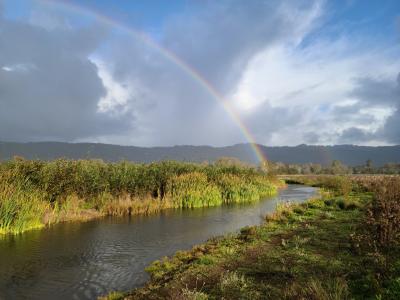Deep Roots — Celebrating 40 Years of Watershed Restoration
April 25 - 28, 2023
Riparian Corridors: the Link Between Upland and Instream Restoration
28 April 2023
1:30pm - 5:00pm
Session Coordinators:
Thomas H. Leroy, Pacific Watershed Associates
Elise Ferrarese, Trout Unlimited
David Roon, Oregon State University
Riparian corridors are a crucial component of a healthy ecosystem and provide a link between upland and instream watershed processes. Riparian forests, within coastal streams of the Pacific Northwest, significantly influence the stream morphology and overall productivity of aquatic habitat which can, in turn, provide a basis for the health of salmonids throughout their range. Aquatic habitat conditions and associated riparian ecosystem functions needed by salmon and steelhead are diverse and perhaps only marginally understood, but it is clear that restoring disturbed riparian zones to conditions where they can provide multiple ecosystem services is critical to recovering threatened salmon populations resulting from past anthropogenic disturbances, including industrial logging and development. Riparian forests contribute to bio-fluvial-geomorphic processes and overall productivity of a watershed in myriad ways, including: stream bank stability, instream large wood recruitment, stream shading and temperature regulation, nutrient cycling, sediment capture and filtering, food web productivity, carbon dynamics, flood and drought attenuation, and providing floodplain dead standing and downed large wood. In this session we invite speakers to present research and case studies related to riparian forest restoration, and linkages between riparian conditions and salmonid life-cycle requirements. We encourage speakers to create presentations that allow the audience to understand the importance of characterizing existing riparian conditions, evaluating and determining desired future conditions, and developing action plans for riparian forests that allow them to reestablish fully functioning ecosystem services.
Thomas H. Leroy, Pacific Watershed Associates
Elise Ferrarese, Trout Unlimited
David Roon, Oregon State University
Riparian corridors are a crucial component of a healthy ecosystem and provide a link between upland and instream watershed processes. Riparian forests, within coastal streams of the Pacific Northwest, significantly influence the stream morphology and overall productivity of aquatic habitat which can, in turn, provide a basis for the health of salmonids throughout their range. Aquatic habitat conditions and associated riparian ecosystem functions needed by salmon and steelhead are diverse and perhaps only marginally understood, but it is clear that restoring disturbed riparian zones to conditions where they can provide multiple ecosystem services is critical to recovering threatened salmon populations resulting from past anthropogenic disturbances, including industrial logging and development. Riparian forests contribute to bio-fluvial-geomorphic processes and overall productivity of a watershed in myriad ways, including: stream bank stability, instream large wood recruitment, stream shading and temperature regulation, nutrient cycling, sediment capture and filtering, food web productivity, carbon dynamics, flood and drought attenuation, and providing floodplain dead standing and downed large wood. In this session we invite speakers to present research and case studies related to riparian forest restoration, and linkages between riparian conditions and salmonid life-cycle requirements. We encourage speakers to create presentations that allow the audience to understand the importance of characterizing existing riparian conditions, evaluating and determining desired future conditions, and developing action plans for riparian forests that allow them to reestablish fully functioning ecosystem services.
Redwoods Rising: Resetting the Standard of Parks Management,
Andrew Morin, Fisheries Biologist, National Park Service
Andrew Morin, Fisheries Biologist, National Park Service
Incorporating Invasive Species Management into Riparian Restoration Design and Implementation at the Redwood National and State Parks Visitor Center and Restoration Project, Amy Livingston, McBain Associates
Evaluating the Effects of Riparian Forest Thinning on Stream Ecosystems in Coastal Northern California Watersheds,
David Roon, Post-doc, Oregon State University
David Roon, Post-doc, Oregon State University
Is More Light Good for Fish?: Results from a Riparian Buffer Manipulation on Private Timberland in the Oregon Coast Range,
Ashley Sanders, graduate student, Oregon State University
Ashley Sanders, graduate student, Oregon State University
Effects of Experimental Riparian Canopy Gaps on Fish, Salamanders, Biofilms and Ecosystems Processes in Headwater Streams,
Dana Warren, Associate Professor, Oregon State University
Dana Warren, Associate Professor, Oregon State University
Riparian Canopy Modification Experiment: Lessons Learned and Results from Salmonid and Coastal Giant Salamander Monitoring in an Experimental Watershed in Northwestern California,
Mathew Nannizzi, Aquatic Biologist, Green Diamond Resource Company
Mathew Nannizzi, Aquatic Biologist, Green Diamond Resource Company
Effectiveness of Meadow and Wet Area Restoration as an Alternative to Watercourse and Lake Protection Rules,
Christopher G. Surfleet, Professor, California Polytechnic State University San Luis Obispo
Christopher G. Surfleet, Professor, California Polytechnic State University San Luis Obispo

